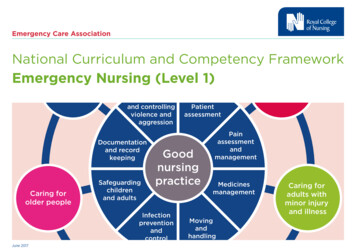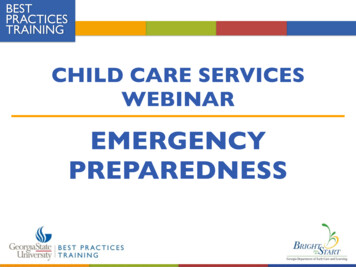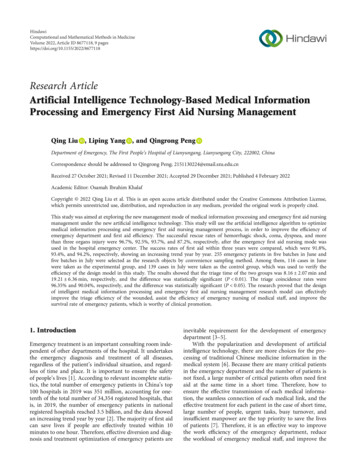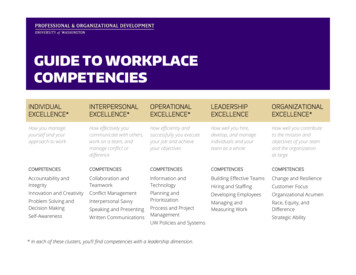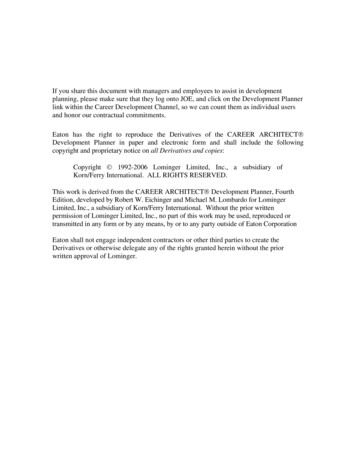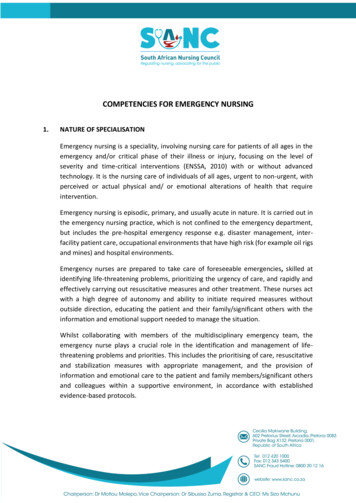
Transcription
COMPETENCIES FOR EMERGENCY NURSING1.NATURE OF SPECIALISATIONEmergency nursing is a speciality, involving nursing care for patients of all ages in theemergency and/or critical phase of their illness or injury, focusing on the level ofseverity and time-critical interventions (ENSSA, 2010) with or without advancedtechnology. It is the nursing care of individuals of all ages, urgent to non-urgent, withperceived or actual physical and/ or emotional alterations of health that requireintervention.Emergency nursing is episodic, primary, and usually acute in nature. It is carried out inthe emergency nursing practice, which is not confined to the emergency department,but includes the pre-hospital emergency response e.g. disaster management, interfacility patient care, occupational environments that have high risk (for example oil rigsand mines) and hospital environments.Emergency nurses are prepared to take care of foreseeable emergencies, skilled atidentifying life-threatening problems, prioritizing the urgency of care, and rapidly andeffectively carrying out resuscitative measures and other treatment. These nurses actwith a high degree of autonomy and ability to initiate required measures withoutoutside direction, educating the patient and their family/significant others with theinformation and emotional support needed to manage the situation.Whilst collaborating with members of the multidisciplinary emergency team, theemergency nurse plays a crucial role in the identification and management of lifethreatening problems and priorities. This includes the prioritising of care, resuscitativeand stabilization measures with appropriate management, and the provision ofinformation and emotional care to the patient and family members/significant othersand colleagues within a supportive environment, in accordance with establishedevidence-based protocols.
The emergency nurse will use clinical judgement and critical reasoning skills to managethe emergency patient and consequently implement interventions with the aim torestore stability, prevent complications and achieve and maintain optimal responsesand outcomes for all patients.The emergency nurse will be professionally equipped to serve the community as aspecialist emergency practitioner in the pre-hospital inter-facility and hospitalenvironment. Such emergency nurse will be able to function independently with basic,intermediate and advanced clinical competencies, which are recognised bothnationally and internationally in the emergency environment.In the Emergency Department (ED) they will perform as independent, interdependentand dependant clinical practitioners, leaders, consultants and specialist practitionersin providing evidence-based care to patients and their families/significant others asset out by the relevant legislative frameworks.The emergency nurse will be able to: 2.Function competently and professionally in the emergency environment.Have a range of skills, knowledge and attitudes to enable them to make ameaningful contribution to the provision of emergency health services.Display a sense of equity, justice and ethics to ensure accountability.Actively resuscitate patients facing life threatening situations within anyemergency settingProvide primary, secondary and tertiary care to patients during, but not limitedto, the acute phase of illness or injury, ranging from prevention to rehabilitationand end of life care; a trauma system supportive approach.Work as a specialist practitioner with other team members within the health caresystem in the prevention of morbidity and mortality; before, during and afteremergencies.UNIQUENESS OF EMERGENCY NURSINGEmergency nursing encompasses a field of nursing where the focus is on the care ofpatients of all ages who are experiencing either perceived or actual minor to lifethreatening emergencies, which are managed in collaboration with members of thehealthcare team. Emergency nursing takes place along a continuum, which starts fromthe scene of the accident or initial illness (pre-hospital setting), transfers to anappropriate care facility (inter-facility setting) and the emergency department (hospitalenvironment), where the emergency nurse functions within a complex technologicalenvironment and displays a high level of knowledge, skill and competence in caring forthe patient and family/ significant other until discharged home, to an appropriate wardor rehabilitation centre.2
2.1 The emergency settingThe emergency setting includes basic level, intermediate level and advancedcapabilities, based on various accreditation frameworks. The basic level facilityoffers emergency first response and stabilisation (primary health care clinic). Theintermediate facility (regional) offers sufficient resources to initially stabilize andcommence management. The advanced facility (tertiary/academic) offersdefinitive care and comprehensive emergency services (Calvello, Tenner, Broccoliet al, 2015). Care within the emergency setting spans the full spectrum ofprevention and curative care and may include rehabilitative care within a healthywork environment.The emergency nurse is also an integral component of the first line of emergencydefence in a major incident or a disaster. Providing health care in these situationspresents many unusual challenges, such as an unstable environment, managingwith limited human and material resources, and safety risks, while caring forpatients during their most vulnerable time.A lack of sufficient resources will require optimum prioritisation, creativity andimprovisation in order to manage patients properly (Powers and Daily, 2010).Emergency nurses furthermore play a vital role in the provision of military healthcare services. The military emergency nurse executes this unique role in unsafe,unstable situations, often in a hostile environment, where the emphasis is placedon ethical conduct towards own and enemy forces in need of care. In this role itis expected of the military nurse to simultaneously function as a soldier and ahealth care provider.The occupational emergency nurse executes this unique role in unsafe, unstablesituations, and often unhygienic environments (dust, mud and rock falls), wherean emphasis is placed on legal compliance with Health and Safety standards asgoverned by the Compensation for Occupational Injuries and Diseases Act (COIDA)and the Mine Health and Safety Act. In this role it is expected of the occupationalemergency nurse to function as both an employee and a health care provider.3
2.2 The Emergency Nurse is able to carry out the following core skills: Address injury prevention initiatives on primary, secondary and tertiarylevels, in order to identify and provide education to the community throughprogrammes to promote wellness and prevent injuries, such as alcoholawareness, child passenger safety, gun safety, bicycle and helmet safety,and domestic violence prevention etc.Critically reflect on practise and analyse epidemiology evidence (studies reburden of disease and injuries) to determine and implement injuryprevention strategies on a primary (before the injury happens), secondary(assuring appropriate, timeous level of care) and tertiary (community-basededucation in preparation of return of the patient to the community) level.Triage and respond to the rapidly changing physiological and psychologicalstatus of complex emergency care patients based on haemodynamicparameters, with a focus on mechanism of injury or history of the illness andthe presenting signs and symptoms.Analyse the mechanisms of injury and/or pre-hospital history and/or thepatient’s clinical presentation to formulate patient-centred interventionsand health and safety precautionary measures.Be prepared to take care of any foreseeable emergencies, while focusing onthe time and criticality aspects of the patient.Have a broad clinical knowledge, demonstrate sound clinical judgement andinitiate appropriate management, urgent to non-urgent, in time-critical andoften overcrowded, chaotic environments.Have a flexible and adaptable approach, to appropriately manage thedynamic and often uncontrolled environment and patient situations foundin the Emergency settings.Collaborate with the multi-disciplinary team to assess, diagnose, prioritise,stabilise and transfer or discharge a patient population that encompassesthe whole human life span, with perceived or actual minor to severephysical and/or emotional alterations of health that are undiagnosed orrequire further interventions.Initiate appropriately and sensitive contact and conversations (sometimesdifficult) with patients and family/ significant others, employers andcolleagues about the progression of care during their healthcare journey.2.3 Different settings for provision of careEmergency nursing consists of care delivered in the pre-hospital, inter-facility andhospital environment, which is often challenging and usually time-sensitive. Thisenvironment includes, but is not limited to the following settings:4
3.Pre-hospital, which includes major and minor incidents or disasters; andmilitary, mining and hostile environments;Industrial and occupational environments;Inter-facility, which includes road, water and air evacuation interventions,and maintaining care during inter-facility transfers (which may include theinitiating of care in a mobile environment, e.g. the emergency nurse workingon a ship or an aeroplane) or in open/dangerous areas such as the mines etc.Hospital, including emergency department/unit) and associated definitivecare facilities.OVERLAP OF COMPETENCIESWhile each of the study areas below may yield a stand-alone qualification, there isshared knowledge and skills (commonalities) among these, creating an overlap of somecompetencies. This will probably have educational implications, where some modulesmay have to be shared by the different specialities. It is possible that some of thenamed disciplines may not become full qualifications, depending on educationalrequirements and the percentage of core content.Emergency Nursing competencies overlap with one another and should includecomponents of: Intensive Care/Critical Care NursingOrthopaedic Nursing and Neurological NursingMedical and Surgical Nursing CarePaediatric and Neonatal Emergency Nursing CareMaternal/Obstetrical Emergency NursingForensic NursingOperating Theatre NursingCommunity Health Nursing5
4.SUMMARY OF CORE COMPETENCIESDOMAIN 1: PROFESSIONAL, ETHICAL AND LEGAL PRACTICESUBDOMAIN/CORESPECIFIC COMPETENCYCOMPETENCY1.1. ProfessionalPractice1.1.1 Accept accountability for increased responsibility,including own professional judgment, actions, outcomes ofcare, ethical practice and continued competence inaccordance with legislation and policy frameworks (bothnational and international).1.1.2 Engage in continuous professional development, utilisingformal and informal platforms, by reflecting andrecognising own level of competence and limitations, seekdevelopment opportunities and record developmentactivities to provide evidence of life-long learning.1.1.3 Commit to the development of peers, students and othercategories of healthcare providers by creating a healthypractice environment that promotes and fostersprofessional growth and resilience.1.1.4 Foster professional autonomy and accountability withinthe independent, dependant and interdependent roles ofthe Emergency Nurse within themselves and others.1.1.5 Actively participate in activities and affairs of professionalassociations and regulatory bodies to advocate forprofessional matters and emergency care (specificallyemergency nursing) in the development of legislation andpolicies, including the improvement of emergency carepractices.1.1.6 Collaborate with the multi-disciplinary team to ensure ateam-based approach in the care of emergency patients,and collective learning and implementation of evidencebased practice.1.1.7 Promote access to emergency care as a right to all SouthAfricans as stipulated by the Constitution of South Africa.6
1.2. Researchactivities forProfessionalPractice1.2.1 Contribute towards improving knowledge by conducting orsynthesising research and other evidence that reveals,examines and evaluates current emergency nursingpractice, knowledge, theories, criteria and creativeapproaches to ultimately improve emergency care andprofessional development.1.2.2 Engage in research activities to inform evidence-basedpractice, to improve and promote optimal patientoutcomes.1.2.3 Disseminate research findings through activities, such aspresentations, publications, consultations and journalclubs to a variety of audiences that include but are notlimited to healthcare providers in the emergency caresetting.1.2.4 Critically analyse and discuss the findings of research withinthe healthcare team in the field of emergency care, andnegotiate for the implementation of relevant andappropriate applicable research findings in the emergencysetting.1.2.5 Provide and translate evidence-based recommendationsfor patients with complex, acute, critical illness/injury oratypical presentations.1.2.6 Analyse the effects of community systems, resources suchas Emergency Medical Service (EMS) pre-hospitalprotocols, and identify opportunities for improvement topromote optimal emergency care.7
1.3. Legal Practice1.3.1 Practice in accordance with professional and otherrelevant international and national legislation applicableto specialist nursing practice and the special patientpopulation (emergency patients).1.3.2 Recognise and act upon laws relating to the professionalrole and/or professional Code of Conduct.1.3.3 Practice in accordance with current emergency carepolicies and evidence-based procedural guidelines andprotocols.1.3.4 Interpret and evaluate current regulations to develop orimplement clinical practice guidelines and policies forsituations of violence, neglect and abuse.1.3.5 Identify, mitigate and manage potential and actualmedico-legal risks in the emergency setting, and thereporting thereof to the relevant authorities.1.4. Ethical Practice1.4.1 Deliver emergency care in a manner that preserves andprotects the autonomy, dignity, rights, values, beliefs andpreferences of health care workers, patients and theirfamily/significant others in the midst of challenging,unpredictable emergency settings.1.4.2 Participate in ethical and legal debates concerningcomplex decisions and orders in the emergency setting,for example: end of life decisions (do not attemptresuscitation or do not escalate care/palliative care) andcare of the vulnerable populations. This includes researchactivities.1.4.3 Acknowledge the significance and contribution of theemergency patient and family/significant others in ethicaldecision making in conjunction with the multidisciplinaryteam, and assisting them to make informed decisions.1.4.4 Maintain and advocate for patient autonomy andconfidentiality within the legal and ethical framework ofemergency care, and the patient’s access to emergencycare.8
1.4.5 Intervene according to legislative guidance in cases ofillegal, unethical or inappropriate behaviour that exposesthe emergency patient to risk and jeopardizes the bestinterests of the patient, e.g. report suspected criminalactivity and adverse events to relevant structures,including the regulatory body.1.4.6 Recognise, address and respond appropriately to safety andquality improvement concerns in emergency care practices.1.4.7 Participate in and advocate for the patient,family/significant others and the profession in all aspects ofdecision making, especially in ethical dilemmas and timeconstrained situations. Serve as a mentor and role model byparticipating in the resolution of ethical and clinicaldilemmas.1.4.8 Advocate for staff in addressing risks and safety concerns inthe emergency setting (violence towards staff, patients,family/significant others), promoting advancement andpositive practice environments whilst recognisinglimitations, legal responsibilities and scope of practice.1.4.9 Display sensitivity to cultural, professional andtechnological diversity within the multi-disciplinary teamand emergency care continuum.1.5. Coaching1.5.1. Serve as a mentor, role model and expert resource for prehospital personnel, inter-professional/ inter-disciplinarycolleagues and students, as well as nurses and EMS staff.1.5.2. Develop, implement and evaluate educational programmesrelated to emergency care (e.g. triage, trauma, psychiatricemergencies, disaster management etc.).1.5.3. Facilitate the recognition, prevention, referral andtreatment of stress responses among emergency careproviders as it relates to critical incidents, compassionfatigue, vicarious trauma, acute stress disorder or posttraumatic disorder.9
1.6. Major Incident 1.6.1 Recognise the fundamental approaches to major incidentand Disasterand disaster nursing, including nursing in a combatPracticesituation.1.6.2 Display competencies related to preparedness,organisation and implementation of appropriate responseswithin an ethically challenging environment, whilst applyinghealth policy and organisational and personnel planning foremergencies.DOMAIN 2: CLINICAL PRACTICE – CARE PROVISION AND MANAGEMENTSUBDOMAIN/CORESPECIFIC COMPETENCYCOMPETENCY2.1. Prevention2.1.1 Critically reflect on practise and analyse epidemiologythrough healthstudies (burden of disease and injuries) to determine andpromotionimplement injury prevention strategies on a primary(before the injury happens), secondary (assuringappropriate, timeous level of care) and tertiary(community-based education in preparation of return ofthe patient to the community) level.2.1.2 Create awareness through collaboration and engagementwith the community (professional and non-professional) inan attempt to avert or reduce episodes of critical illness andthe burden of injury (health promotion and injuryprevention).2.2.3 Develop and communicate critical discharge advice andinformation, including health promotion and injuryprevention information, to the emergency patient and/orfamily/significant others in order to assist them to plan andmanage their own care effectively.10
2.2. EssentialClinical skills,includingcompetenciesacross thespectrum forthe primary,resuscitativeand secondaryphases ofEmergencyCare2.2.1 Engage in a continuous cycle of assessment (primary andsecondary survey), planning and implementation ofinterventions, and evaluation and re-evaluation of theeffectiveness thereof.2.2.2 Collaboratively and continuously analyse, record andreport interventions, patient response and progress, asdirected by care-appropriate management tools.2.2.3 Considers the unique age-specific aspects of assessment,planning, implementation and evaluation techniquesduring all phases of emergency care for the followingvulnerable patient population: bariatric, physically andmentally challenged, cognitive impaired, forensic, geriatric,new-born, paediatric, pregnant, psychiatric.2.2.4 Promote optimal family-centred care in the emergencynursingpractice involving, but not limited to the following: Collaboration with the patient, family/significantothers and multi-disciplinary team members toestablish a holistic and individualised plan ofemergency care;Provide assurance and appropriate information tofamily/significant others, including the employer;Encourage the family, employer/colleagues to remaininvolved with the care of the patient;Provide regular, honest, relevant and realisticinformation;Collaborate with other services to provide on-goingsupport;Use of language consistent with the level ofunderstanding.2.2.5 Consider psychosocial aspects in the care of the emergencypatient/family as well as the professional emergency staff.2.2.6 Operate various relevant/ appropriate types of technologyused in the emergency and health care setting safely andappropriately.2.2.7 Apply timeous critical thinking and clinical judgment anddecision making underpinned by scientific, biomedical andtechnological knowledge in the emergency setting toprioritise and deduce comprehensive, individual care for11
the emergency patient, in collaboration with the relevantmultidisciplinary team.2.2.8 Monitor the haemodynamic, biomedical and clinical effectsof the disease/injury processes and multiplepharmacological agents used in the emergency setting,such as but not limited to analgesics, anti-microbialtherapy, cardio-vascular and respiratory agents, as well asantidotes.2.2.9 Manage and optimise the emergency nursing context(physical, psychological and physiological) in a professionalmanner to the benefit of emergency patients,families/significant others and other health care workers,for example: trol;Implement appropriate bundles of care, e.g. todecrease healthcare associated infections;Ensure equipment in the emergency setting is checked,maintained and readily available for use;Provide a safe space for the mentally ill and victims ofabuse.2.2.10 Monitor, critically evaluate and re-evaluate interventionsand progress of the patient condition regularly, asdetermined by the signs of patient improvement and/ordeterioration, care management tools, and incollaboration with the multidisciplinary team.2.2.11 Specific minimal clinical skills:--Open and maintain an airway, using basic and advancedskills.Management of oxygenation and ventilation, includingbut not limited to using a bag-valve-mask device, peepvalve and mechanical ventilation. Interpretation ofVenous Blood Gas and Arterial Blood Gas and making thenecessary changes to ventilator settings.Able to obtain peripheral and intra-osseous vascularaccess.Fluid resuscitation (manage massive fluid resuscitation ormassive blood transfusion).12-lead ECG interpretation.Basic life support (BLS).Use of a manual defibrillator.12
2.3. Clinicalcompetenciesfor PrimaryCare provision2.3.1 Assess for environmental hazards and take immediateaction to protect the patient, bystanders, colleagues andthe members of the multidisciplinary team to ensure thesafety of the emergency care environment. This includesaccessing the appropriate resources or disciplines toprovide safety.2.3.2 Apply biomedical and social sciences knowledge such acology, educational, psycho-socio-cultural, ethical,legal and economical contexts of disease to assess anemergency patient (e.g. primary, secondary and continuoussurvey).2.3.3 Triage and prioritise patient care based on haemodynamicparameters, with a focus on mechanism of injury, history ofthe illness and/or presenting clinical signs and symptoms.2.3.4 Promptly assess and intervene when life-threateningconditions are present.2.3.5 Implement interventions to monitor and maintain airwaypatency while protecting the patient’s cervical spine, usingthe appropriate evidence-based practice guidelines.2.3.6 Implement interventions to monitor and maintainventilation and oxygenation that include basic,intermediate, advanced and difficult airway interventions,using the appropriate evidence-based practice guidelines.2.3.7 Implement interventions to monitor and maintaincirculation, using the appropriate evidence-based practiceguidelines.2.3.8Implement appropriate immobilization accordingly.Implement interventions to assess and evaluate theneurological status of the patient, utilizing the correctequipment and techniques and using appropriate scoringsystems (disability).2.3.9.Implement interventions to monitor and maintain themetabolic status of the patient.13
2.4. .1 Implement the resuscitative actions, guided by bestpractice guidelines in accordance with the findings from thehistory and primary survey.2.4.2 Implement the prioritised interventions based on theassessment and findings, including the use of appropriatetechnological devices e.g. automated external defibrillator(AED), defibrillator (internal/external) and external pacing.2.4.3 Utilise evidence-based formulae to accurately calculatedrug dosages, fluid volumes, blood and blood products; andadminister drugs, fluids, blood and blood products for theemergency patient population, while observing forresponses and reactions to the proposed treatment.2.4.4 Implement individualised, comprehensive, evidence-basedcare, based on the findings of the scientific, biomedical andtechnological assessment of the emergency patient tidisciplinary collaboration.2.4.5 Prepare for, assist with and perform procedures on theemergency patient, including execution of insightful postprocedure observations, e.g. thoracotomy, lethoracentesis, CVP, intra-costal drains and intra-osseousaccess.2.4.6 Communicate effectively and timeously within themultidisciplinary team in relation to consultation andreferral of complex problems or deterioration in thepatient’s status.2.4.7.Practice effectively as a leader and member of theemergency team.2.5. Clinical2.5.1 Systematically assess the emergency patient from head-tocompetenciestoe (secondary survey) to identify actual and potentialfor provision ofinjuries or underlying conditions.Secondary Care2.5.2 Continuously and timeously re-evaluate the interventionplan, and prioritise care.14
2.5.3 Interpret the relevant data of the emergency patient fromthe various data sources, to direct further care.2.5.4 Ensure the comfort of the patient through appropriatebasic strategies such as: decreasing spine board times, painmanagement, positioning and splinting of fractures.2.5.5 In collaboration with the multi-disciplinary team, validatethe emergency patient’s response to interventions, inkeeping with a patient-centred approach and being awareof the time-sensitive environment.2.6. Clinicalcompetenciesfor transferand receivingof patientsfrom EMS andotherhealthcareproviders2.6.1 Actively participate in decision making on transfer ofpatients to appropriate care facilities.2.6.2 Ensure continuity of care through an accurate, systematicand comprehensive handover to the healthcare providersof the next level of care, e.g. ward, intensive care unit (ICU),operating room (OR) or transferring facility.2.6.3 Be cognisant of available resources, and initiate referrals toensure timely and relevant referral, to promote optimalpatient outcomes.2.6.4 Prepare, package and monitor while accompanying theemergency patient to ensure safe intra-hospital and interfacility transportation.2.7. Therapeutic2.7.1 Use advanced communication and interpersonal skills tocommunicationinitiate, develop and discuss therapeutic relationships withandemergency patients, their families or significant others.relationships2.7.2 Practice active listening skills in an unbiased manner,respect points of view of others, and promote theexpression of diverse opinions and perspectives.2.7.3 Establish and apply open channels of communication(written, non-verbal and verbal) within the emergencysetting.2.7.4 Be role models for and encourage patient-centredcommunication, including patients with compromised15
communication ability, in the challenging emergencyenvironment.2.7.5 Advocate for the patient in relation to all interventions andorders, especially in relation to clinical trials, “do notresuscitate” orders and termination of life support.2.7.6. Communicate with the family of the emergency patient toorientate them about the emergency care interventions,technology and the patient status (especially when there isa change in the patient’s status) e.g. in cases of familypresence during resuscitation, and to foster smoothtransition of the patient across the emergency setting.2.7.7 Establish rapport with the emergency patient and families/significant others through active listening, giving honestand appropriate answers, displaying a non-judgmentalattitude etc.2.8. Clinical practice 2.8.1 Systematic assessment and provision of major incident,anddisaster and combat nursing by assessing needs andmanagementplanning, providing and managing care in a resource limitedin a majorenvironment while maintaining core competencies.incident,combat or2.8.2 Care for vulnerable people and their families/significantdisasterothers in a hostile, often unsafe or unstable environment,situationusing appropriate competencies. Treat people with specialneeds and maintain ethical judgement towards woundedenemy soldiers, hostile population groups or victims ofhostile actions.2.8.3 Provide care management in emergency and disastersituations, using competencies for maintaining the careenvironment and team system with insufficient resources,which requires improvisation and initiative.2.8.4 Support the maintenance of the care environment throughcompetencies in maintaining environmental health, minehealth, ensuring safe water, optimal sanitation andmaintaining hygiene in a major incident, disaster or combatscenario. These competencies may necessitateimprovisation in respect of communications/ informationsharing, cold chain management, supply of equipment andsterility.16
2.8.5 Display professional development competencies,including:-Monitoring, mentoring and evaluation, with a focus oncompetency in leadership;Co-ordination and team work in a hostile environmentsetting, while maintaining accountability as well aslegal/ethical aspects.DOMAIN 3: QUALITY OF PRACTICESUBDOMAIN/CORESPECIFIC COMPETENCYCOMPETENCY3.1. QualityImprovement3.1.1 Always adopt safe practice. Regularly analyse theemergency care system and its philosophy to alignemergency nursing accordingly, e.g. aligning with thePrimary Health Care approach, the implications ofNational Core Standards for Emergency Nursing Practice,other national health care programmes such as theStrategy for Nursing Education, Training and Practice,infection control programmes, Mine Health and Safetystandards, disaster programmes and adhering to bestpractice guideli
Emergency nursing is a speciality, involving nursing care for patients of all ages in the emergency and/or critical phase of their illness or injury, focusing on the level of severity and time-critical interventions (ENSSA, 2010) with or without advanced technology. It is the nursing care o
